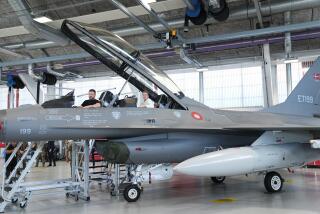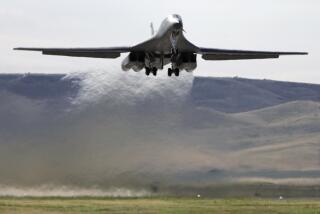F-15 fleet is grounded after a jet falls apart
- Share via
WASHINGTON — The Air Force has grounded its entire fleet of F-15s, the service’s premier fighter aircraft, after one of the planes disintegrated over eastern Missouri during a training mission, raising the possibility of a fatal flaw in the aging fighters’ fuselage that could keep it out of the skies for months.
Gen. T. Michael “Buzz” Moseley, the Air Force chief of staff, ordered the grounding Saturday after initial reports indicated that the Missouri Air National Guard fighter plane had broken apart Friday in midair during a simulated dogfight. The pilot ejected and survived.
Although the 688 F-15s in the Air Force’s arsenal are gradually being replaced by a new generation of aircraft -- the F-22 -- they remain the nation’s most sophisticated front-line fighters.
U.S. officials said that the F-15s are heavily used for protecting the continental U.S. from terrorist attacks, as well as for combat missions in Iraq and Afghanistan.
Lt. Gen. Gary L. North, the Air Force officer in charge of military aircraft in the Middle East, said in a statement Monday that he would be able to fill the gap with other fighters and bombers in his arsenal.
But another Air Force official said the F-15 grounding would have a “significant impact” on operations in Iraq and Afghanistan. “They will clearly have to work hard to pick up the slack,” the official said.
The health of the F-15 fleet has long been a concern for Air Force brass, who repeatedly have warned that the two-engine fighter has exceeded its expected life span and is straining under the workload imposed by the counter-terrorism duty.
In addition, Moseley has repeatedly raised concerns that the plane is inadequate for increasingly sophisticated air defense systems being developed by potential adversaries like China and Iran.
“The F-15s . . . they’re very capable airplanes,” Moseley told a congressional hearing last month. “But against the new-generation threat systems, they don’t have the advantage that we had when they were designed in the late 1960s and built in the 1970s.”
In May, another Missouri Air National Guard F-15 crashed in southern Indiana during a similar training exercise. That pilot survived as well.
The F-15 that crashed Friday was 27 years old. Of the five different versions of the F-15 currently used by the Air Force, four versions average between 24 and 30 years of age.
The F-15E, the newest version, is only 15 1/2 years old, but it has been grounded along with the other versions because it has a similar airframe.
Air Force leaders have frequently cited the age and obsolescence of the F-15 as the main reason to buy the new, more stealthy F-22, the most expensive fighter ever made.
Critics of the F-22, which was first designed to fight a generation of Soviet MiGs that never materialized, have argued it is an overpriced Cold War relic, but the Air Force says it has adapted the plane to meet more modern threats and missions.
Lt. Gen. David Deptula, a former F-15 pilot who is now the Air Force head of intelligence, said that his son now flies the exact same F-15 aircraft that Deptula flew while based in Japan in the late 1970s.
“They have become serious maintenance challenges as they get older, and now I’d suggest that we may be facing a crisis,” Deptula said.
“We must recapitalize our aging fighter forces -- and fast.”
Loren Thompson, a military analyst with the Lexington Institute who has consulted for aircraft manufacturers, said the accident was probably caused by metal fatigue, corrosion or faulty maintenance.
If maintenance problems turn out to be the culprit, Thompson said, the F-15 fleet could be returned to flight relatively quickly. Similarly, corrosion could be addressed by examining other aircraft for similar problems.
If the Missouri crash was the result of metal fatigue, however, it could lead to a much more extended grounding, since it would suggest that time and intense use of the aircraft since the Sept. 11 attacks have finally caught up with the aging fighter.
“The whole fleet was already flying on flight restrictions due to metal fatigue,” said Thompson, noting that a fleetwide grounding is extremely rare, especially for a fighter.
“In this case, the planes that are grounded are supposed to be America’s top-of-the-line air-superiority plane,” Thompson added. “This is not like grounding some cargo plane. These are the sinews of our global air dominance.”
Despite fears over the plane’s safety, it remained unclear whether all F-15s were on the ground or would stay there. Lt. Col. Edward W. Thomas Jr., an Air Force spokesman, said that over North America, counter-terrorism missions were being taken over by the single-engine F-16 fighter, but that some F-15s would be on standby during the transition period.
Similarly, an Air Force official said North, the Air Force commander in the Middle East, would keep some F-15Es on hand in case of an emergency.
“They’re not going to put their aircraft on the flying schedule, but if they really need the combat capability and you’ve got troops in harm’s way, they’re going to launch them,” the official said.
According to Air Force officials, Moseley and other senior officers were alarmed after it became clear that the accident in Missouri was the result of the plane simply breaking apart during a relatively basic exercise.
Capt. Bridget Zorn, a spokeswoman for the Missouri Air National Guard, said the pilot had been released from the hospital with a dislocated shoulder and broken arm.
She said investigators were still in the early stages of their inquiry, marking and identifying pieces of wreckage at the site, about 120 miles southwest of St. Louis.
--
More to Read
Sign up for Essential California
The most important California stories and recommendations in your inbox every morning.
You may occasionally receive promotional content from the Los Angeles Times.










